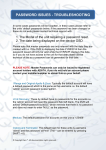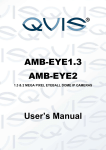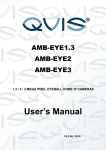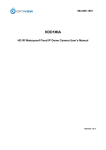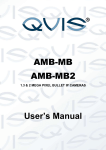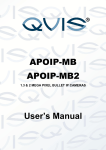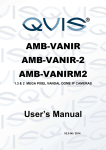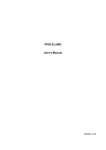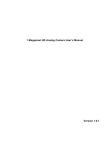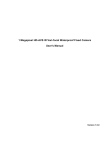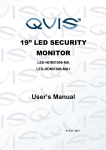Download F Series Indoor IP User`s Manua
Transcript
HDCVI-MB1 HDCVI-EYE1 1 Megapixel HDCVI Bullet & Dome Cameras User’s Manual V1.0 06 / 2014 i Welcome Thank you for purchasing either the HDCVI Bullet or Eyeball Dome cameras. This user’s manual is designed to be a reference tool for the installation and operation of your camera setup. Here you can find information about the corresponding HDCVI camera’s features and functions, as well as a detailed installation method. Before installation and operation please read the following safeguards and warnings carefully! ii Important Safeguards and Warnings 1.Electrical safety All installation and operation here should conform to your local electrical safety codes. The power supply shall conform to the requirement in the SELV (Safety Extra Low Voltage) and must make sure that the limited power source is rated 12V DC or 24V AC. Please note: Do not connect two power supplying sources to the device at the same time; it may result in device damage! We assume no liability or responsibility for all the fires or electrical shock caused by improper handling or installation. We are not liable for any problems caused by unauthorized modification or attempted repair. 2.Transportation Security Please ensure that the product does not endure heavy stresses, violent vibration or contact with water during transportation, storage and installation. Please use the original packing material (or the material of the same quality) if you need to return it to vendor. 3.Installation Do not apply power to the product before completing installation. Do not put object(s) on the product. Please install a proper power cut-off device during the installation connection. 4.Qualified engineers needed All the examination and repair work should be done by the qualified service engineers. We are not liable for any problems caused by unauthorised modifications or attempted repair. 5. Environment This product should be installed in a cool, dry place away from direct sunlight, inflammable, explosive substances and etc. Please keep it away from environments that contain electromagnetic radiation or objects that produce it. Please keep sound ventilation around the device at all times. Do not allow the water and other liquid to penetrate into the device if casing has been compromised. This series product complies with the IP66 standard specified in the Degrees of Protection Provided by Enclosure. Ensure lightning surge protection is in place to make sure you fully protect camera circuitry from electrical overload. iii Please make sure the CCD (CMOS) component is away from the radiation of the laser beam device. Otherwise it may result in CCD (CMOS) optical component damage. It is recommended that the grounding studs of the product should be grounded, so to further enhance the reliability of the camera. 6. Daily Maintenance Please shut down the device and then unplug the power cable before you begin any maintenance work. Do not touch the CCD (CMOS) optic component. Please use an air jet to clean the dust off the lens surface. You can use the dry cloth with some alcohol or mild detergent to clear if necessary. When the camera is not in use please put the dustproof cap to protect the CCD (CMOS) component. Do not use volatile solvent such as the benzene, paint thinner or detergent with the ability to abrade surfaces. It may result in lens damage or adversely affect the device’s performance. 7. Accessories Always use all the accessories recommended by manufacturer. Before installation, please open the package and check that all the components are included. Contact your local retailer/vendor ASAP if something is missing. iv Table of Contents 1 General Introduction..........................................................................................................1 1.1 Overview...................................................................................................................1 1.2 Features..........................................................................................................1 1.3 Functions ........................................................................................................1 1.4 Specifications..................................................................................................2 2 Framework and Dimensions...................................................................................4 2.1 HDCVI-MB1 ....................................................................................................3 2.2 HDCVI-EYE1………........................................................................................5 3 Installation ...............................................................................................................6 3.1 HDCVI-MB1.....................................................................................................6 3.2 HDCVI-EYE1……............................................................................................7 v 1 General Introduction 1.1 Overview Our megapixel HD camera conforms to the HDCVI standard. It supports high speed transfer of video signals over long distance transmissions without any delay. It can be controlled by a DVR that also conforms to the HDCVI standard. One of the other main features this camera includes is the IR night vision, which aids in video surveillance when the camera is functioning within a low illumination environment. The LED IRs highlight objects of interest within the camera’s field of view and is then able to filter out any visual interference so that you can easily view footage upon a monitor. It supports real-time monitor and listening at the same time via the inbuilt microphone. If you want to communicate with a person(s) in view of the camera it also supports dualway bidirectional talk. The built-in protection enclosure and waterproof design conforms to the IP 66 level. It has the sound waterproof function suitable for use in the outdoor environments. 1.2 Features • • • • • • • • • High-performance CMOS image sensor, which produces megapixel quality definition. HD video, coaxial cable to transmit the control signal. Supports 75-3 coaxial cable transmission without any loss. Transmission distance is over 500m. High speed, long distance real-time transmission. Supports ICR switch to allow for surveillance in both the daytime and at night. Supports auto exposure, auto white balance, auto electronic shutter and auto gain function. Supports DC12V power supply. IP66 compliance. Supports intelligent IR function. 1.3 Functions HDCVI Specification HDCVI (High Definition Composite Video Interface) is an over-coaxial-cable HD video transmission standard. The technology renders two HD video formats by progressively scanning the signal. ICR The IR cut removal feature filters the IR light in the daytime and then auto switches to the general filter at night. This function allows the camera to output balanced and clear video. Smart IR technology The sensor controls the IR light and can switch it on/off via hardware and software working in combination, which can automatically provide IR light compensation according to the environment illumination conditions. © Copyright Qvis ®. All documentation rights reserved. 1 Auto gain function This outputs the standard video signal under different illumination environments. The amplifier can automatically adjust within a wide range. The system can enhance the camera sensitivity in low illumination and enhance the video signal output to produce clear and high definition video. Auto white balance This function allows the camera to automatically adjust the color temperature of the video footage if the camera is either in an indoor and outdoor environment, just like our human eyes does. Auto exposure System can automatically set the shutter speed and iris value according to the snapshot video exposure conditions. Auto electronic shutter The system can automatically adjust the electronic shutter when the environment’s light changes. © Copyright Qvis ®. All documentation rights reserved. 2 1.4 Specifications 1.4.1 Performance Please refer to the following sheet for network camera performance specification: Parameter Video Processor Video Format Effective Pixel Min Illumination Electronic Shutter Video Standard Video Frame Rate Lens Port Lens Type Day/Night Switch Sync Mode Video Output White Balance Gain Control BLC IR Light Control Plan Transmission Distance Smart IR Max IR Distance Protection Level Working Temperature / Humidity Power Power Consumption Dimensions (mm) Weight Installation Mode HDCVI-MB1 HDCVI-EYE1 1/2.9" 1.0 Mega Pixels CMOS PAL/NTSC 1280 (H) x 720 (W) 0.01Lux @ (F1.2,AGC ON), 0Lux with IR PAL:1/50s~1/100,000s NTSC:1/60s~1/100,000s HDCVI compliant PAL:1280×720@25 fps NTSC:1280×720@30 fps M12 2.8/3.6/6/8mm optional ICR mechanic auto switch INT 1-channel HDCVI high definition video output Auto Auto Auto Advanced non-photosensor control plan Over 500m via 75-3 coaxial cable. Supported 20m IP66 N/A -30 ~+60℃℃. Humidity is less than 95%(no condensation) DC 12V±10% 3.5W MAX (Input: 12V 0.29A) φ65.0×154.7 380g Wall Mount © Copyright Qvis ®. All documentation rights reserved. 2.5W MAX (Input: 12V 0.21A) φ113.6×85.4 200g Wall mount/in-ceiling mount 3 2 Framework & Dimensions 2.1 HDCVI-MB1 Please refer to the following figures for dimension information. The unit is mm. See Figure 2-1 and Figure 2-2. Figure 2-1 Figure 2-2 Please refer to the following sheet for detailed information. SN 1 2 Name Double-circle glasses Lens 3 IR Lights 4 Device body 5 6 Power input port Video output port Function Protective lens, sensitive optical part. Do not touch. This is to allow the optical light from the environment into the camera. These are to send out the IR compensation light to enhance the night vision. This is the main supporting part of the camera. It includes sunshield cap, front cap, rear part, bracket, etc. Connect to the DC 12V power supply. • BNC port: This is to output the HDCVI video signal. • You can connect to the devices such as the DVR or the NVS conforming to the HDCVI specifications. © Copyright Qvis ®. All documentation rights reserved. 4 2.2 HDCVI-EYE1 Please refer to the following figure for dimension information. The unit is mm. See Figure 2-3 and Figure 2-4. Figure 2-3 Figure 2-4 SN 1 Name IR Lights 2 Lens 3 4 Device body Camera Dome decoration ring Power input port Video output port 5 6 Function These are to send out the IR compensation light to enhance the night vision. This is to allow the optical light from the environment into the camera. This is the main supporting part of the camera. Allows installer to fix camera to surface. Connect to the DC 12V power supply. • BNC port: This is to output the HDCVI video signal. • You can connect to the devices such as the DVR or the NVS conforming to the HDCVI specifications. © Copyright Qvis ®. All documentation rights reserved. 5 3 Installation Important: Please make sure the installation surface can support a minimum of 3X weight of the camera and the bracket. 3.1 HDCVI-MB1 (Bullet Camera) Step 1: Drill three holes into the installation surface (wall or the ceiling). Insert three expansion bolts into the three holes and then lock firmly. See Figure 3-1. Figure 3-1 SN 1 2 3 4 Item Name Installation Surface Bracket Screws Cameras Step 2: First prepare the cable according to the cable requirements. Line up the three screw holes at the bottom of the bracket with the three installation holes in the wall or the ceiling, and then insert three screws into the three holes on the chassis of the bracket and fix them firmly. Now secure the bracket onto the installation surface of the wall or the ceiling. Step 3: Adjust the camera to point in the direction of the desired monitor area via the three directions indicated in Figure 3-2 after you fixed the camera into place. © Copyright Qvis ®. All documentation rights reserved. 6 Figure 3-2 Step 4: Connect the device’s video output port to the DVR device. Then connect the power cable to the device. Now you have completed the device installation and cable connection. You can use the terminal encoding device to monitor the video footage produced by the camera. 3.2 HDCVI-EYE1 (Mini Dome Camera) The dome camera is suited to a ceiling location installation. But it can also be installed onto a wall or other flat surfaces if required. Step1 Please take the installation position map in the accessories bag, and then paste it on the ceiling or the wall according to your monitoring area requirements. Draw and then drill three holes into the installation surface and then insert three expansion bolts into the holes. Secure these three bolts firmly. Step 2 Turn the decoration ring counter clockwise to remove it. Please drill a “cable exit hole” in the surface according to the installation position map, if you want to draw out the cable from the top of the installation surface. You need to draw out the cable from the cable channel side port on the pedestal if you want to lead it away from the camera. Adjust the device’s installation pedestal to the proper position and then draw the cable through the cable exit. Line up the three screw holes in the device pedestal to the three plastic expansion bolt holes in the installation position. Put the three self-tapping screws in the three plastic expansion bolts firmly. Now the dome camera is secure in the installation surface. See Figure 3-3. © Copyright Qvis ®. All documentation rights reserved. 7 Figure 3.3 Step 3 Adjust the lens to get the clearest monitor video quality. See Figure 3-4. Use a crosshead screwdriver to loosen the screw and the turn the camera body to the proper position manually. Fix the screw again. Important: Do not remove the screw. Only loosen it a little. Please secure after you completed the setup. Figure 3-4 © Copyright Qvis ®. All documentation rights reserved. 8 Step 4 Line up the bulge of the decoration ring to the nick found on the camera body and install along the tilt installation. Push and then turn decoration ring clockwise. The installation is complete after you secure the decoration ring. You need to use the proper tool to open up the side port for the U-cable channel from the decoration ring if you want to draw out the cable from the side port of the cable channel when you are installing the device cable. Then you can draw out the cable from the cable channel of the pedestal. Finally you can install the decoration ring to complete the installation. See Figure 3-5. Figure 3-5 © Copyright Qvis ®. All documentation rights reserved. 9 For more information about our other Analogue Cameras and other available HDCVI equipment, DVRs, NVRs & accessories, please visit our website: www.adata.co.uk Alternatively scan this QR code with your smart phone to be directed instantly to our website: © Copyright Qvis ®. All documentation rights reserved. 10

















